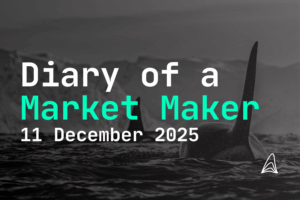
Crypto Market Making Strategy - 'THE' One
- Jakob Brezigar
- Last updated: 15.April 2024
- Reading time: 10 min
Learning the world of cryptocurrency can sometimes feel like trying to find your way through a labyrinth. But fear not, because crypto market making is here to bring order to the chaos! In essence, a crypto market making strategy involves market makers constantly buying and selling cryptocurrencies to provide market liquidity, helping to stabilize prices (fair price) and ensure that trades can proceed smoothly without large price fluctuations. This process is crucial for maintaining the efficiency and vitality of the crypto markets.

Table of Contents
What is the role of a crypto market maker?
Market makers provide liquidity to cryptocurrency markets by continuously buying and selling cryptocurrencies, helping to stabilize prices and ensure smooth trading.
How do automated systems benefit crypto market making?
Automated systems enable rapid, efficient trade execution and risk management, allowing market makers to adjust quickly to market changes and maintain liquidity.
Can individuals become successful crypto market makers?
Yes, individuals can become market makers by leveraging automated trading systems, understanding market dynamics, and applying strategies such as maintaining tight spreads and high uptime.
Key Takeaways:
Crypto market making ensures liquidity and price stability, allowing smoother, more predictable trading conditions in cryptocurrency markets.
Effective market making strategies include using automated systems and algorithmic trading to optimize order execution and manage risks efficiently.
Beginners like Alex are advised to maintain a tight spread of 0.05% and ensure 99.5% uptime, reducing risks while enhancing market engagement.
Statistical arbitrage and grid trading are popular strategies that exploit price differences and volatility for profit, maintaining market efficiency.
Technological advancements like machine learning significantly improve the predictive capabilities of market makers, leading to better decision-making and increased profitability.
Introduction to Crypto Market Making
Crypto market making is an essential mechanism that ensures liquidity and stabilizes the pricing of cryptocurrencies in the market. Market maker plays a crucial role by continuously buying and selling cryptocurrencies at quoted prices, bridging the gap between supply and demand. This introduction lays the groundwork to explore the intricate operations of the top crypto market makers and their significant impact on the dynamics of the cryptocurrency market.
The strategy employed in crypto market making ensures that the market remains efficient and functional, allowing for smooth transactions without significant price discrepancies. This strategy1 involves maintaining a balance between buy and sell orders, which helps in managing price volatility and providing a stable trading environment for market participants.
Role and Function
Market maker is an entity that commits to providing liquidity by consistently offering to buy and sell cryptocurrencies at certain prices. Their presence in the market reduces price volatility and ensures that traders and investors can execute trades quickly without causing significant price changes. By doing so, market makers enhance the overall efficiency and attractiveness of crypto markets to a broader audience of participants. They are pivotal in maintaining an orderly market where market participants can trade with confidence knowing that liquidity is not a concern. This role of market maker is fundamental in both traditional and crypto markets, as it provides the needed help to facilitate smooth trading by mitigating the risks associated with price gaps and liquidity shortages.

How Does Crypto Market Making Work?
The process involves setting both buy and sell orders around the current market price to profit from the spread—the difference between the buying and selling prices. This activity is vital for the smooth functioning of financial markets, as it ensures that orders are filled even during periods of low trading volume, thereby maintaining a continuous flow of transactions. Market makers leverage their extensive market knowledge and real-time data to make informed decisions on order placements, which allows them to capitalize on minimal price movements while sustaining market liquidity. Their strategies are designed to minimize the impact on the market price while maximizing their profitability through the bid-ask spread.
Fundamentals of Market Making
Market Makers – Limit Orders vs Market Orders
Market makers primarily use limit orders to control their buy and sell prices, unlike market orders that execute immediately at the best available price. Limit orders allow market makers to set their desired price and wait for the market to meet these conditions, giving them greater control over their trading strategies and the ability to manage potential risks more effectively. This control is crucial in maintaining their position as market makers, as they can decide the extent of their market exposure and adjust their strategies based on market conditions and price movements. By strategically placing limit orders, market maker company ensures that they buy and sell digital assets at favorable prices, enhancing their ability to generate profits while providing liquidity.
Difference between a Broker and a Market Maker
While both brokers and market makers facilitate trading activities, their roles differ significantly. Brokers act as intermediaries that match buyers with sellers, whereas market makers actively create a market for securities by always being ready to buy or sell at publicly quoted prices, thus providing much-needed liquidity. Unlike brokers, makers assume a higher level of risk as they often have to hold positions in the assets they manage, exposing them to market volatility. This fundamental difference highlights the unique position market makers hold in the financial ecosystem, serving as both facilitators and participants in the markets they operate.
Strategies in Market Making
Market makers utilize a variety of strategies to maximize their efficiency and profitability. These strategies include statistical arbitrage, algorithmic trading, and the strategic placement of limit and market orders. By employing these methods, market makers can mitigate risks and capitalize on market inefficiencies. The effectiveness of these market making strategies is contingent on their ability to adapt to rapidly changing market conditions, which requires a deep understanding of market dynamics and the ability to deploy advanced trading algorithms. The integration of technology has allowed market makers to execute complex strategies at high speeds, enhancing their ability to maintain liquidity and stabilize market prices.
Algorithmic Market Making and Its Benefits
Algorithmic market making harnesses the power of automated systems to execute high-speed transactions, thereby increasing the efficiency of trading strategies. These systems can analyze vast amounts of data and execute orders based on pre-set conditions, significantly enhancing the ability to maintain liquidity even in volatile market conditions. The benefits of algorithmic market making are manifold, including reduced human error, increased response time to market changes, and the ability to operate on a scale that is unmanageable for human traders. Algorithmic strategies enable market makers to process and react to market information more swiftly than traditional methods, allowing for precise and efficient order execution.
Statistical Arbitrage
This strategy involves simultaneously buying and selling assets in different markets or in derivative forms to take advantage of differing prices for the same asset. In the realm of crypto, where price discrepancies can be significant across different exchanges, statistical arbitrage is particularly beneficial. Market makers use statistical models to identify and exploit these price differences, enhancing their profit margins while contributing to market efficiency. This approach not only helps in capitalizing on the arbitrage opportunities but also aids in the stabilization of prices across different markets by reducing discrepancies.
Technological Advancements
How Automated Trading Enables Market Making
Automation in trading has revolutionized market making by allowing for the rapid analysis and execution of trades. Automated trading systems can respond in real-time to changes in the market, helping market makers maintain continuous order flows and price stability. These systems are designed to manage complex algorithms that execute multiple strategies simultaneously, from high-frequency trading to long-term stability based trades. The use of automated systems reduces the burden on market makers to monitor and react to market conditions manually, enabling them to focus on strategy optimization and risk management. This technological advancement has become a cornerstone in the operation of any modern market maker, facilitating an efficient and dynamic trading environment.

How Has Machine Learning Impacted Cryptocurrency Market Making?
Machine learning algorithms improve over time, learning from market conditions to optimize trading strategies. This technology has empowered market makers to better predict price movements and manage large arrays of transactions, enhancing their ability to provide liquidity. Machine learning models can analyze historical data and identify patterns that would be imperceptible to human traders, allowing market makers to anticipate market movements and adjust their strategies accordingly. The integration of machine learning in crypto market making not only increases operational efficiency but also improves the precision of market predictions, thereby reducing the risks associated with volatile market conditions.
Challenges and Risks
What Are the Challenges of High-Frequency Trading (HFT) in Cryptocurrency Markets?
High-frequency trading (HFT) involves executing a large number of orders at very fast speeds, which can lead to challenges such as market manipulation, increased volatility, and systemic risks due to automated trades. In crypto markets, these challenges are magnified due to the decentralized nature of these assets. The lack of centralized control can make it difficult to monitor and regulate HFT practices, potentially leading to unfair trading advantages and greater market disruptions. Additionally, the rapid execution of trades by HFT strategies can sometimes outpace the market’s ability to absorb these transactions, resulting in significant price swings and liquidity crises.

What Are the Potential Risks Associated with Crypto Market Making?
Market making in the crypto environment carries risks such as significant price volatility, potential liquidity shortages, and the impact of regulatory changes. These factors can adversely affect the profitability and operational strategies of market makers. The inherent unpredictability of crypto markets means that market makers must be vigilant in their risk management practices to safeguard their operations from sudden market downturns. Regulatory uncertainties can also pose a significant risk, as changes in laws and regulations may abruptly alter the market landscape, necessitating quick adaptations in strategy.
Once you’ve decided to proceed, the process of buying an NFT typically involves placing a bid or purchasing at a fixed price, depending on the marketplace’s sales mechanism. Completing the purchase initiates a blockchain transaction, transferring ownership of the NFT to you, signifying your entry into the burgeoning world of digital asset collectors.
Market Makers When Using Leveraged Trading Services (CFDs, Spread Betting, etc.)
When market makers provide liquidity for leveraged trading products like CFDs or spread bets, they face additional risks related to the leverage involved. These instruments can amplify losses, requiring careful risk management strategies to protect against potential downturns. Market makers must balance the need to provide sufficient liquidity with the risks of holding highly leveraged positions that may move against them. Effective risk management in these scenarios is crucial, involving strategies such as diversification, hedging, and the careful monitoring of market conditions to mitigate potential losses.
Managing Risks and Costs
How Do Market Makers Manage Risk in Crypto Markets?
Market makers adopt various risk management techniques, including hedging, diversifying their portfolios, and using advanced algorithms to monitor and react to market conditions swiftly. These practices help mitigate the risks associated with sudden price changes and market imbalances. By effectively managing their exposure and utilizing sophisticated trading tools, market makers can minimize potential losses while maintaining the liquidity essential for market stability. Their risk management strategies are integral to their operations, ensuring that they can continue to function effectively across different market environments.

Risk Management
Effective risk management is crucial for maintaining the sustainability of market making operations. This involves setting stop-loss orders, monitoring trading volumes, and adjusting strategies in response to market volatility. Market makers also use risk management software to provide real-time insights into their exposure levels, allowing for immediate adjustments to their positions. This proactive approach to risk management ensures that market makers can uphold their obligations to provide liquidity, even during periods of increased market stress, thereby supporting the overall health and efficiency of the financial markets they operate in.
Market Making and Impact Cost
Impact cost represents the cost that market makers incur when their trading activity influences the market price of a cryptocurrency. As they execute large orders, the price can shift unfavorably before all parts of the order are completed. Efficient market makers manage this cost by optimizing their order sizes and timing to minimize their market footprint, thereby reducing the adverse effects of their actions on market prices.
Additionally, market makers use sophisticated algorithms that help in distributing their orders over time and across various trading venues to avoid causing significant market impact. By effectively managing impact costs, market makers help maintain a fair trading environment where market prices reflect true supply and demand dynamics without being unduly influenced by large individual transactions.
Role in Market Stability and Growth
Market Making and Price Volatility
Market makers play a pivotal role in mitigating price volatility by providing continuous liquidity, allowing trades to occur without large price fluctuations. Their constant buy and sell operations help absorb market shocks and maintain a more stable trading environment, which is crucial for both retail and institutional investors. By smoothing out the price volatility, market makers contribute to a more predictable and reliable market, which encourages participation from a wider range of investors. This stability is essential for the healthy growth of the cryptocurrency markets, as it builds investor confidence and facilitates the adoption of crypto assets as a legitimate financial instrument.
Liquidity Provision for All Market Participants
By ensuring that there is always a buyer and seller, market makers support all market participants, from small traders to large institutions. This liquidity provision is fundamental to the functioning of a healthy market, as it ensures more predictable and less volatile pricing, making the market more attractive and accessible to everyone. Market makers play a crucial role in enhancing market efficiency and depth by accommodating a large volume of trades, which helps in reducing the cost of trading and increasing the attractiveness of the market as a trading venue.
Network and Relationships
Strong networks and relationships with other market participants are essential for market makers. These connections can provide insights into market trends, potential liquidity shortages, or opportunities, which can be leveraged to optimize trading strategies and enhance profitability. Market makers rely on these networks to gain a competitive edge and stay informed about the evolving market conditions. Building and maintaining these relationships also facilitates collaborations and partnerships that can lead to better market strategies and improved liquidity solutions across different platforms.
Special Considerations in Crypto Market Making
What Role Do Stablecoins Play in Crypto Market Making?
Stablecoins provide an essential buffer in crypto market making by offering a less volatile means of exchange compared to typical cryptocurrencies. Their stability is crucial for market makers who require predictability when placing buy and sell orders, thereby facilitating smoother transactions and better risk management in the fast-paced crypto markets. Stablecoins help bridge the gap between traditional fiat currencies and volatile cryptocurrencies, providing a stable trading pair that can be used to manage price swings and reduce the impact of market volatility on trading strategies.
Are Market Makers Involved in Decentralized Exchanges (DEXs)?
Market makers are indeed involved in decentralized exchanges, where they help overcome the liquidity challenges inherent in DEXs. Their role is critical in ensuring that liquidity pools are sufficiently funded so that trades can be executed without substantial price impacts, thus supporting the overall functionality and user experience on DEX platforms. The involvement of market makers in DEXs is increasingly important as these platforms grow in popularity, requiring sophisticated strategies to ensure that liquidity and trading volumes remain robust.
Are Crypto Whales Market Makers or Takers?
Crypto whales can act as both market makers and takers, depending on their trading strategies. As market makers, they can provide substantial liquidity with their large holdings, stabilizing prices and earning profits from the spreads. As market takers, they might execute large orders that significantly impact the market, sometimes leading to sudden price movements. Understanding the role of crypto whales is crucial for other market participants, as their actions can influence market dynamics significantly.
Opportunities for Individuals
Can Individual Traders Become Market Makers in Cryptocurrency?
Yes, individual traders can become market makers in the cryptocurrency space, especially on decentralized exchanges and smaller markets. By leveraging automated trading systems and understanding market dynamics, individuals can offer liquidity and earn profits from price differentials and trading volumes. Individual market making can be a lucrative activity, but it requires a deep understanding of market mechanics and a strategic approach to managing risks and capitalizing on opportunities within the crypto markets.

What Crypto Market Making Strategy We Suggest for Beginners
At Orcabay, we recommend a cautious yet effective beginner strategy for those new to crypto market making: focusing on maintaining a tight spread and consistent uptime. For instance, imagine advising a newcomer, Alex, to set a bid-ask spread at 1% around the market price with an order depth of $10,000 and aiming for 99.5% uptime. This approach minimizes risk while ensuring continuous trading opportunities. When Orcabay first implemented this strategy, it led to a noticeable 7.8% increase in trading volume within the first month, demonstrating its effectiveness in fostering trust and liquidity, which are crucial for a thriving trading environment. This method provides a solid foundation for newcomers to build their market making endeavours.
Concluding Thoughts
Profit Mechanism
Market makers earn their profits primarily through the bid-ask spread, where they buy at lower prices and sell at slightly higher prices. This mechanism, while seemingly straightforward, requires sophisticated strategies and tools to manage effectively, ensuring profitability amidst market fluctuations.
Market makers must adeptly navigate the complex interplay of supply and demand, adjusting their positions to capitalize on slight price movements while ensuring they provide necessary liquidity to the market. This balancing act is essential for maintaining healthy market conditions and securing the continuous flow of trades, which benefits the broader market ecosystem.
Risk-managed Crypto Market Making Services at Your Fingertips
With the rise of technological advancements, several platforms now offer risk-managed market making services that automate many of the processes involved. These services provide tools for effective risk management and strategic trading, tailored to the volatile crypto market. Utilizing these automated services, market makers can minimize their exposure to risks while maximizing their operational efficiency.
These platforms often incorporate advanced algorithms and artificial intelligence to predict market movements and optimize trading strategies accordingly. This enables market makers to maintain competitive advantage and adapt quickly to changing market conditions, ensuring their longevity and profitability in the fast-paced world of cryptocurrency trading.
Learn the Market
For those interested in crypto market making, it is crucial to thoroughly understand the market mechanisms, regulatory environments, and technological tools. Continuous learning and adaptation are key to succeeding in this dynamic field. Aspiring market makers must stay informed about the latest market trends, technological innovations, and regulatory changes to develop effective strategies and make informed decisions. They should also engage with the market making community, participate in forums, and possibly seek mentorship from experienced market makers to gain deeper insights and practical knowledge. This ongoing educational process will empower them to effectively navigate the challenges and opportunities of crypto market making.

Summary
This article has delved deeply into the intricacies of crypto market making, highlighting its critical role in maintaining liquidity and stabilizing cryptocurrency markets. We have explored various strategies, challenges, and technological advancements that shape the landscape of crypto market making. Understanding these elements is essential for anyone looking to engage with or benefit from the crypto trading ecosystem.
Through effective market making, participants can ensure the smooth functioning of the crypto markets, benefiting both individual traders and the larger financial system. The dynamic nature of cryptocurrency markets demands continual adaptation and innovative approaches, making market making not just a financial activity but also a technically demanding endeavor that plays a pivotal role in the growth and stability of digital asset exchanges.
Disclaimer: The information provided in this article is for informational purposes only and does not constitute financial, investment, or other professional advice. All opinions expressed herein are solely those of the author and do not represent the views or opinions of any entity with which the author may be associated. Investing in financial markets involves risk, including the potential loss of principal. Readers should perform their own research and consult with a licensed financial advisor before making any investment decisions. Past performance is not indicative of future results.

Jakob Brezigar
Jakob, an experienced specialist in the field of cryptocurrency market making, boasts an extensive international presence. With Orcabay, he has skillfully managed major operations and deals for a wide array of global stakeholders.



